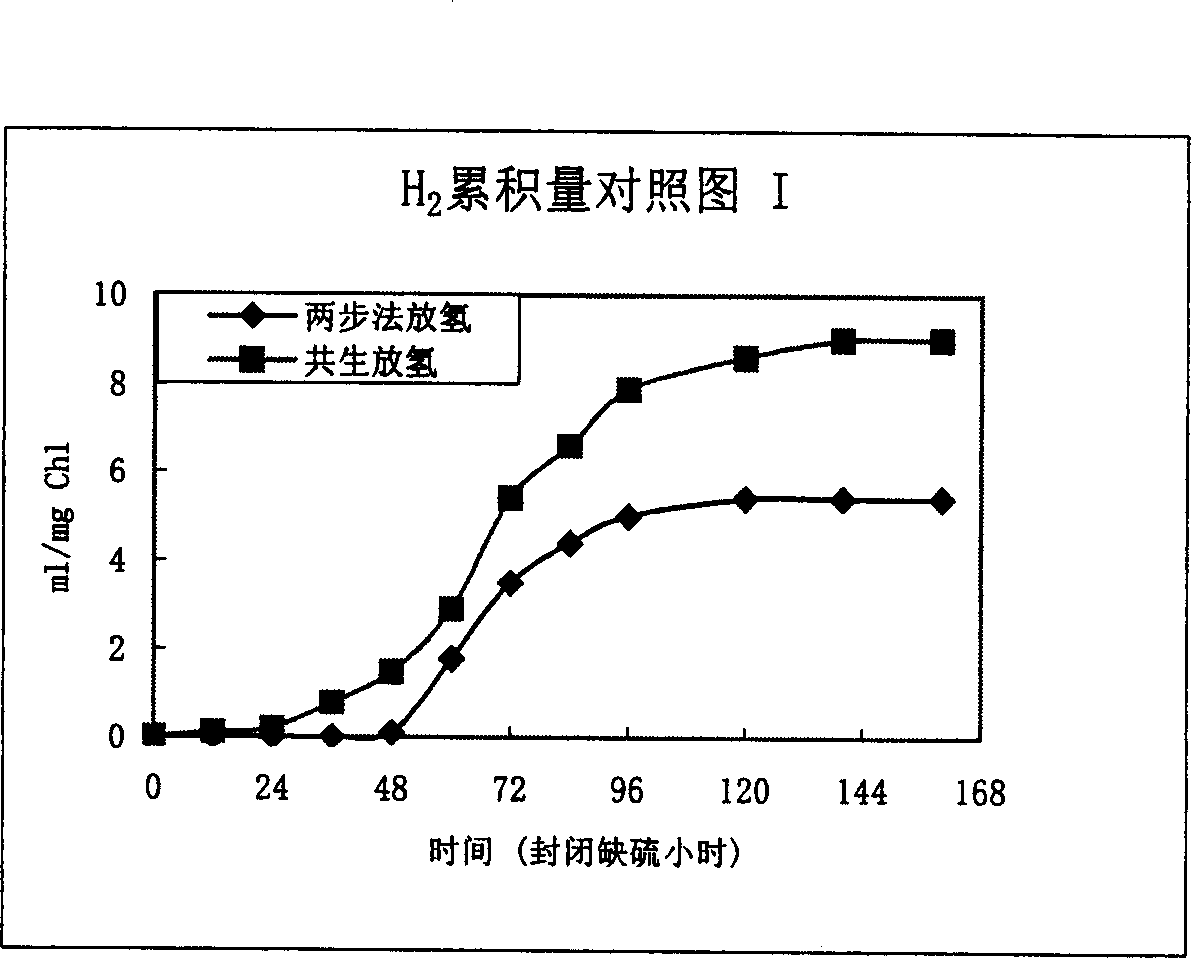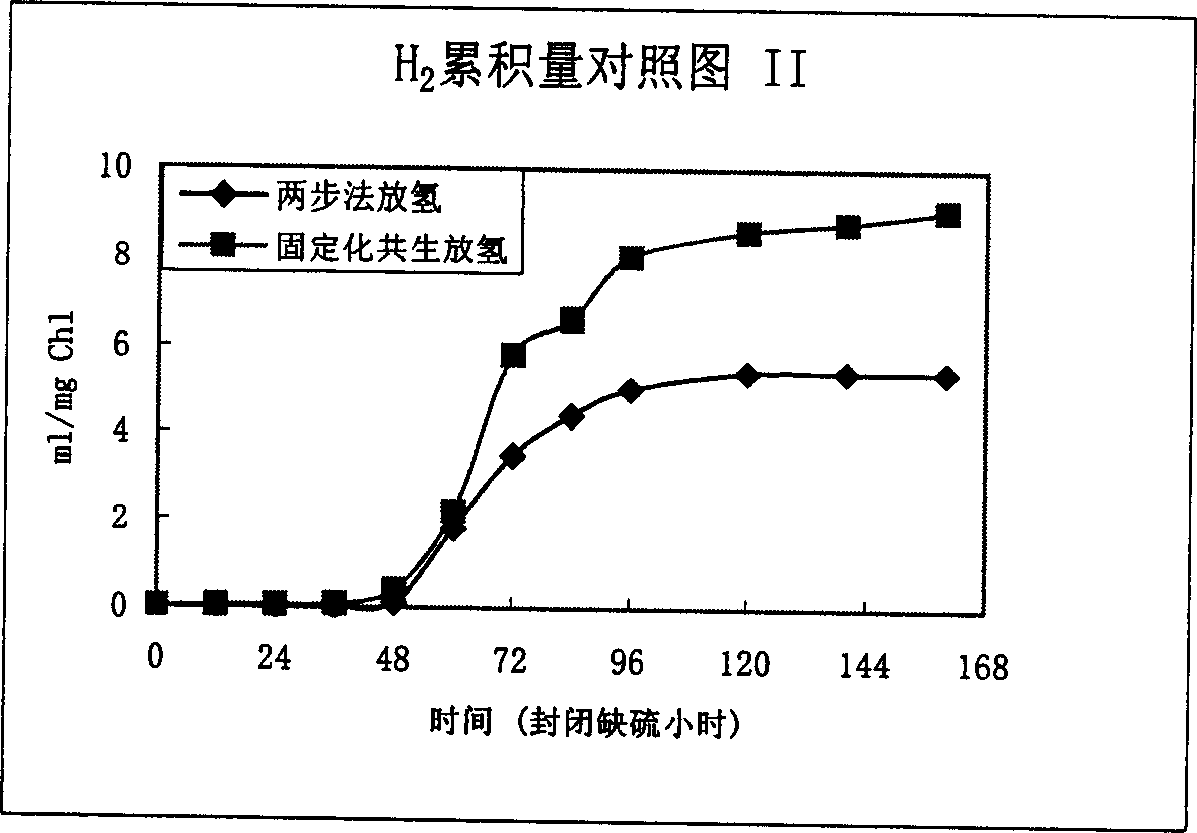Method of increasing hydrogen releasing efficient of chlamydomonas
A Chlamydomonas high-efficiency technology, applied in the field of biological hydrogen production, can solve the problems of limited host cell types, reduced protons, and inability to multiply, and achieve the effect of improving the hydrogen release efficiency of Chlamydomonas
- Summary
- Abstract
- Description
- Claims
- Application Information
AI Technical Summary
Problems solved by technology
Method used
Image
Examples
Embodiment 1
[0014] Example 1 Algae and bacteria symbiotic hydrogen desorption method
[0015] 1. Experimental materials and instruments: Chlamydomonas Chiamy reinhardtii cc125mt+, wild type, purchased from the Chlamydomonas Center of Duke University, USA.
[0016] Culture method: Tris-acetate-phosphate medium (TAP) [11]
[0017] NH 4 Cl 0.4g / L
[0018] MgSO 4 ·7H 2 O 0.1g / L
[0019] CaCl 2 0.0377g / L
[0020] K 2 HPO 4 0.108g / L,
[0021] K H 2 PO 4 0.056g / L
[0022] Tris 2.42g / L
[0023] Glacial acetic acid 1ml
[0024] Trace elements 1ml
[0025] The medium of TAP-S is to contain SO 4 2- The salts are all with the corresponding Cl - Salt replacement, including sulphate in trace elements.
[0026] ST-04 trace water chromatograph (Beijing Analytical Instrument Factory), thermal conductivity detector, N 2 As carrier gas, determined by external standard method, chromatographic workstation JF-9902 (Beijing Analytical Instrument Factory)
...
Embodiment 2
[0036] Example 2 Co-cultivation of Chlamydomonas and immobilized bacteria
[0037] 1. Experimental drugs
[0038] 4% sodium alginate, sterilized at 4°C, 0.05mol / L CaCl 2
[0039] 2. Bacteria immobilization method
[0040] 1). Collect the bacteria by centrifugation at 1000g, wash twice with sterile water, and use the OD of the bacteria solution 600 between 0.5000-0.6000;
[0041] 2). Add the obtained bacteria paste to 1 / 3 volume of TAP-S medium and mix well;
[0042] 3). Add 2 times the volume of 4% sodium alginate and mix well;
[0043] 4). Add 0.05mol / l CaCl 2 Incubate in a water bath at 37°C for 10 minutes;
[0044] 5). Put the mixture of sodium alginate and bacteria paste into the syringe, and use a No. 9 needle to drop CaCl 2 in solution;
[0045] 6). Pour off the solution and rinse once with sterile deionized water;
[0046] 7). Re-add 00.05mol / L CaCl 2 Solution, equilibrate at 4°C for 6 hours;
[0047] 8). Pour off the CaCl 2 solution, washed twice with TAP-...
PUM
| Property | Measurement | Unit |
|---|---|---|
| absorbance | aaaaa | aaaaa |
Abstract
Description
Claims
Application Information
 Login to View More
Login to View More - R&D
- Intellectual Property
- Life Sciences
- Materials
- Tech Scout
- Unparalleled Data Quality
- Higher Quality Content
- 60% Fewer Hallucinations
Browse by: Latest US Patents, China's latest patents, Technical Efficacy Thesaurus, Application Domain, Technology Topic, Popular Technical Reports.
© 2025 PatSnap. All rights reserved.Legal|Privacy policy|Modern Slavery Act Transparency Statement|Sitemap|About US| Contact US: help@patsnap.com


